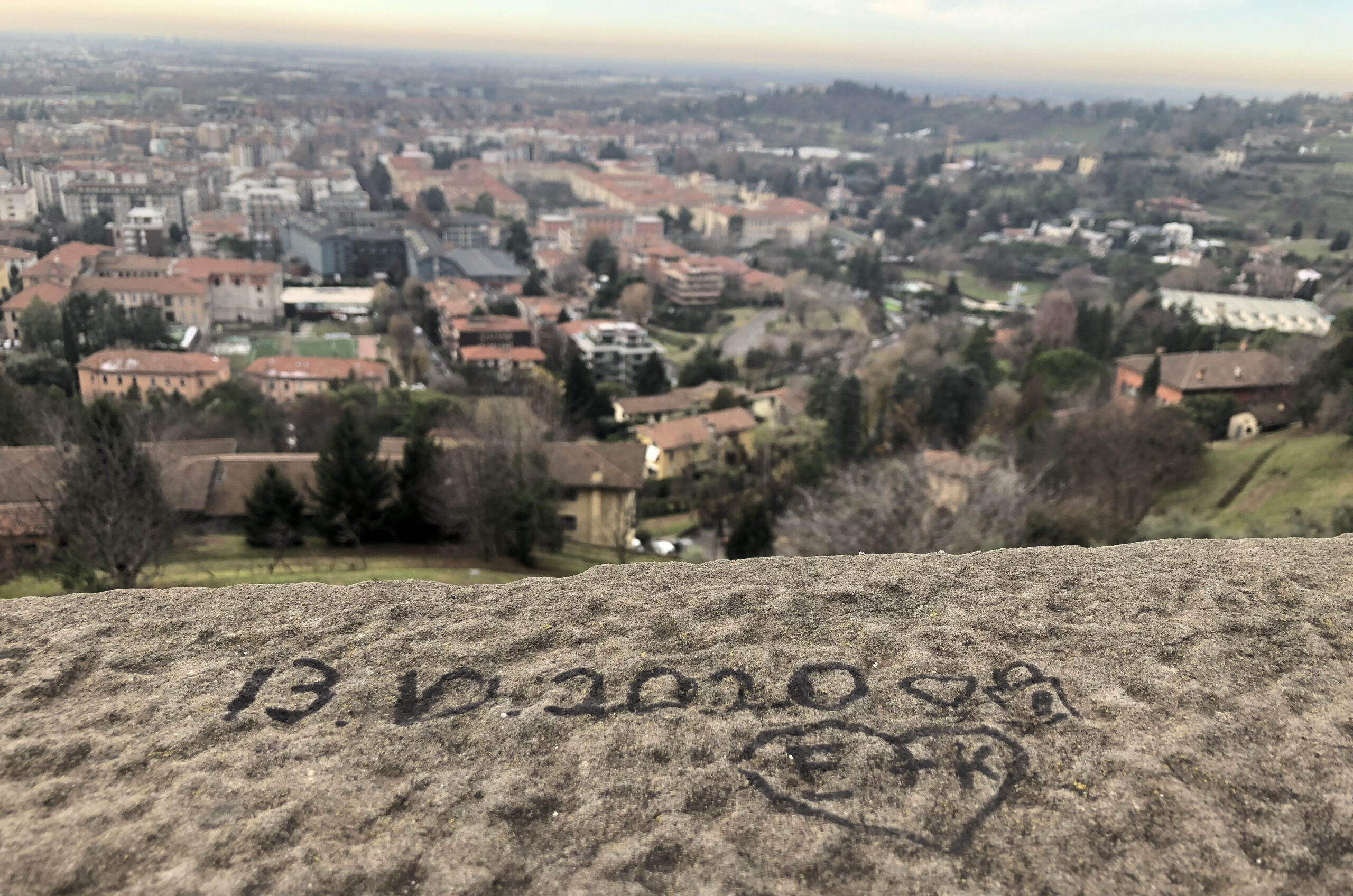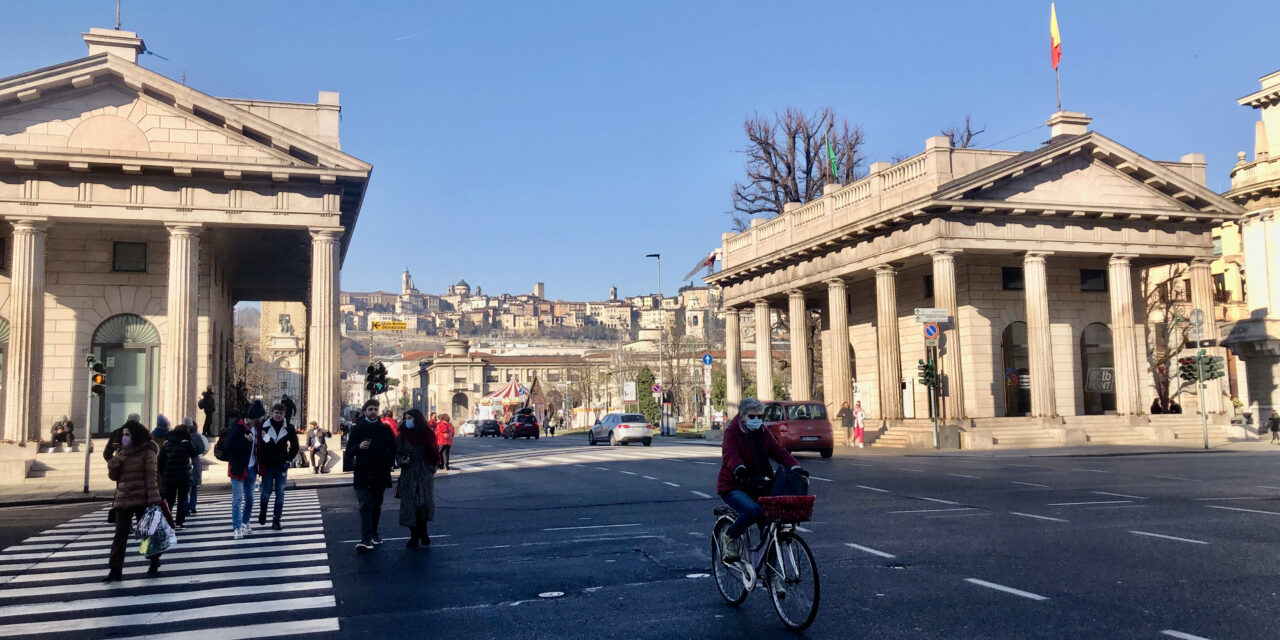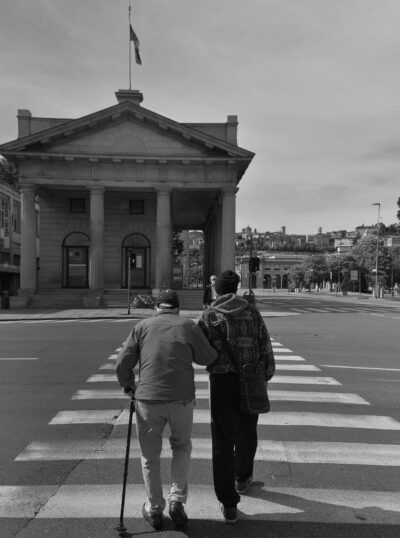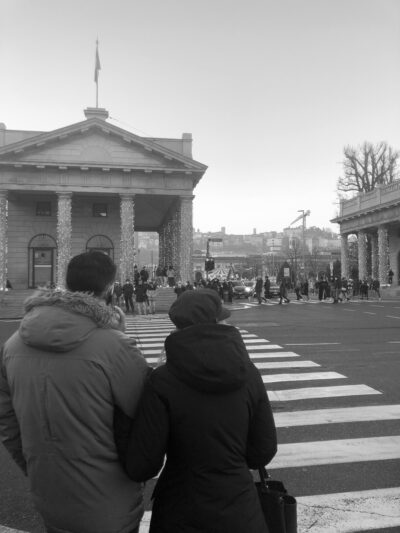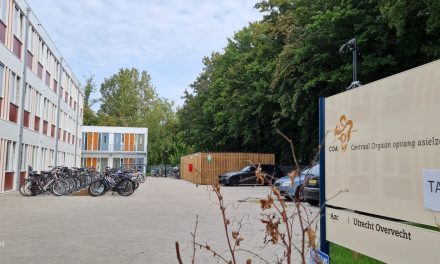Facemasks has become an essential part of the wardrobe from the citizens of Bergamo. When walking on the streets, you see a pairs of eyes with beneath a hidden mouth and chin. That is covered with all kinds of masks. The normal medical mask, the FFP2 mask, masks with colors, every kind you can think of. Some of the stylish people even wear a matching mask with the rest of their clothing. When talking to each other with the typical Italian hand gestures, the masks stay all the way on. ‘With everything we have been through, we accept the masks and gladly wear them. Even though in the beginning it was also very strange for us’, says Nicola Brugali. He works as a data scientist at Intwig in Bergamo. But two years into the pandemic wearing it has become the most normal thing in the world. Surprisingly, no masks are found anywhere in the streets. Either people wear them or throw them away at home or in the trashcans. The people in Bergamo think that in other places than Bergamo people are more careless with the masks. In Europe, but even in Italy. ‘When I visited Belgium and the Netherlands, people gave me weird looks because I always wore my mask, even outside. For us is that the new normal.’
Two years ago, when this pandemic started, the city in the north of Italy was terribly hit by Covid. The city was known for the viral pictures of the army tanks transporting the dead bodies to surrounding towns from Bergamo. The huge cemetery in Bergamo couldn’t keep up with all the people that died. Aldo Cristadoro lived and worked in Bergamo during the first wave of Covid. ‘The situation here was like war, something that was almost unreal. We will never forget what happened, it will forever be in our memory. When we were working from home, we heard the sirens from the ambulances all day long. So when I hear ambulances now, I immediately think about that time.’ The city has 120,000 habitants and the whole province a little bit over 1 million. During the first wave, in the city almost 600 people and in the province 7,000 people died of Covid. With these numbers, Bergamo was seen as the epicenter of Covid in the beginning of this pandemic.
The main street in Bergamo. All the traffic goes through this road, the pedestrians are respected and thought about. This crossing now and almost 2 years ago.
Surviving the unreal
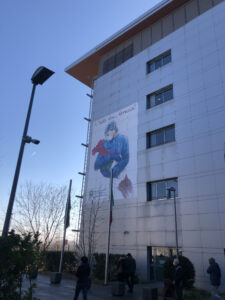
A mural on the outside walls of the hospital made by Franco Rivolli. It is dedicated and a sign of respect towards healthcare workers during the pandemic.
‘It was a really hard time for my city, we were not prepared for this kind of tragedy. It was strange to handle this kind of situation and trying to manage it.’ Says Giorgio Gori, the mayor of the city in his office. The city hall is located in the lower part of Bergamo, Citta Bassa. Chattering, laughing and sounds from the streets echoes through his office, it is Friday afternoon, so the people are excited to start their weekends. The same street 2 years ago, looked way different. Back then it was totally empty and everyone was inside. ‘We had not enough face masks, instruments and resources. We had nothing to treat explicit Covid, so we needed to manage that. But also caring for our citizens. I was committed to speak with them, to give them a feeling of reassurance and trust.’ Meanwhile, the hospitals were flooded with sick people. ASST Papa Giovanni XXIII Hospital is a large and modern hospital in Bergamo, 15 minutes away from the city center. During the first months of the pandemic, the hospital went through a hectic time. Doctor Luca Lorini is since 2018 the director of the Emergency Department and Critical care. He was on the front line when the tragedy started. ‘The situation was something that I couldn’t imagine in my life. It felt like a movie. All 24 hours of the day the sound of siren from the ambulances outside the hospital. There were no beds for people that came in. We had difficulties to get the right number of supplies, like face masks and ventilation machines.’ During the crisis in February and March 2020 the hospital had 100 patients in the intensive care unit intubated and ventilated. According to doctor Lorini, this is one of the biggest intensive care units in the world. It originally had 88 beds, but they transformed another 12 beds to make space for even more patients that came in. Outside the intensive care there were another 150 beds with a CPAP helmet, this is a different kind of ventilation. In December 2021 there were 12 patients with Covid in the ICU and 32 outside of the ICU.
One thing that got the city through the worse situation, is ‘Mola Mia’. This is a phrase in Bergamasque, the dialect from Bergamo. This phrase can’t be translated to other languages, even in Italian. If you translate it in English the result is ‘grinding wheel’, but in other words, it means ‘never give up’. It is typical from this area, because Bergamo is characterized by a long entrepreneur tradition and the culture of hard work. It means a lot for the Bergamaschi. When thinking and talking about Mola Mia, the citizens immediately smile and laugh. A reaction to the situation was to keep going and looking forwards and not backwards. That is one of the reasons why Bergamo is performing on levels as 2019.
Light at the end of the tunnel
Bergamo is not totally out of the woods yet, just like the rest of the world. But the city is doing well. When the Netherlands was in lockdown, Bergamo was very much alive. All the stores and restaurants are open and in the streets you see nothing but heads. Although it is very busy, it doesn’t cause an unsafe feeling. Everyone wears a mask and the city has one of the highest vaccine rates. Gori: ‘The experience we had made us aware of the risk, more than other Italian cities. Then I saw my citizens accept the vaccination campaign more than other cities. We have the highest vaccination rate in Italy. This is also for the masks and the behavior. There is no way to joke with the people in Bergamo about Covid. They knew face to face what the virus was, for this reason they are more compliant with the rules.’
In December 2021 there were 12 patients in the intensive care and 32 outside. 10 times better than in the beginning. The kind of patients there are now: same age, same mortality, same long hospital stay. But 90% is not vaccinated. In the last 4 months: September, October, November and December the hospital had 53 patients in the intensive care and 40 of them weren’t vaccinated. The probability that without the vaccine is 36% more than you have a vaccine. Doctor Lorini: I’m really disturbed by people that don’t get the vaccine. I have to take care of everyone that comes in this hospital, so we can’t deny them care. But I think that it is not correct if you don’t get the vaccination. I think that any country has to obligate of vaccine now. It is too dangerous. It requires a lot of work and money that don’t get to other equally important things, like accidents, cancer, heart attacks. All the work and money that goes into caring for unvaccinated people doesn’t go to the above things and that is not correct. I think we have to obligate the vaccine, otherwise you can stay outside of the hospital. If you want to increase the number of vaccinations, you have to discriminate. Here only people with the green pass can go to a football match, the cinema or skiing, that is also a way of discriminating. But I think that is fair for everyone.’ There already is a vaccination obligation for teachers and healthcare workers in Italy. But this extended, since the 8th of January Italian citizens above the age of 50 are obligated to get the vaccine. Employees above 50 need to have a super green pass to access their workplace. In Italy they work with a green pass and the super green pass. For the super green pass, a vaccination or a recovery is required, but for the green pass a negative test is also valid. The places where you have to show these will be expanded. From 1 February 2022, the vaccination obligation is extended, without age limits, also to the staff of universities, institutions of higher artistic, musical and dance training and higher technical institutes.
Enlarge
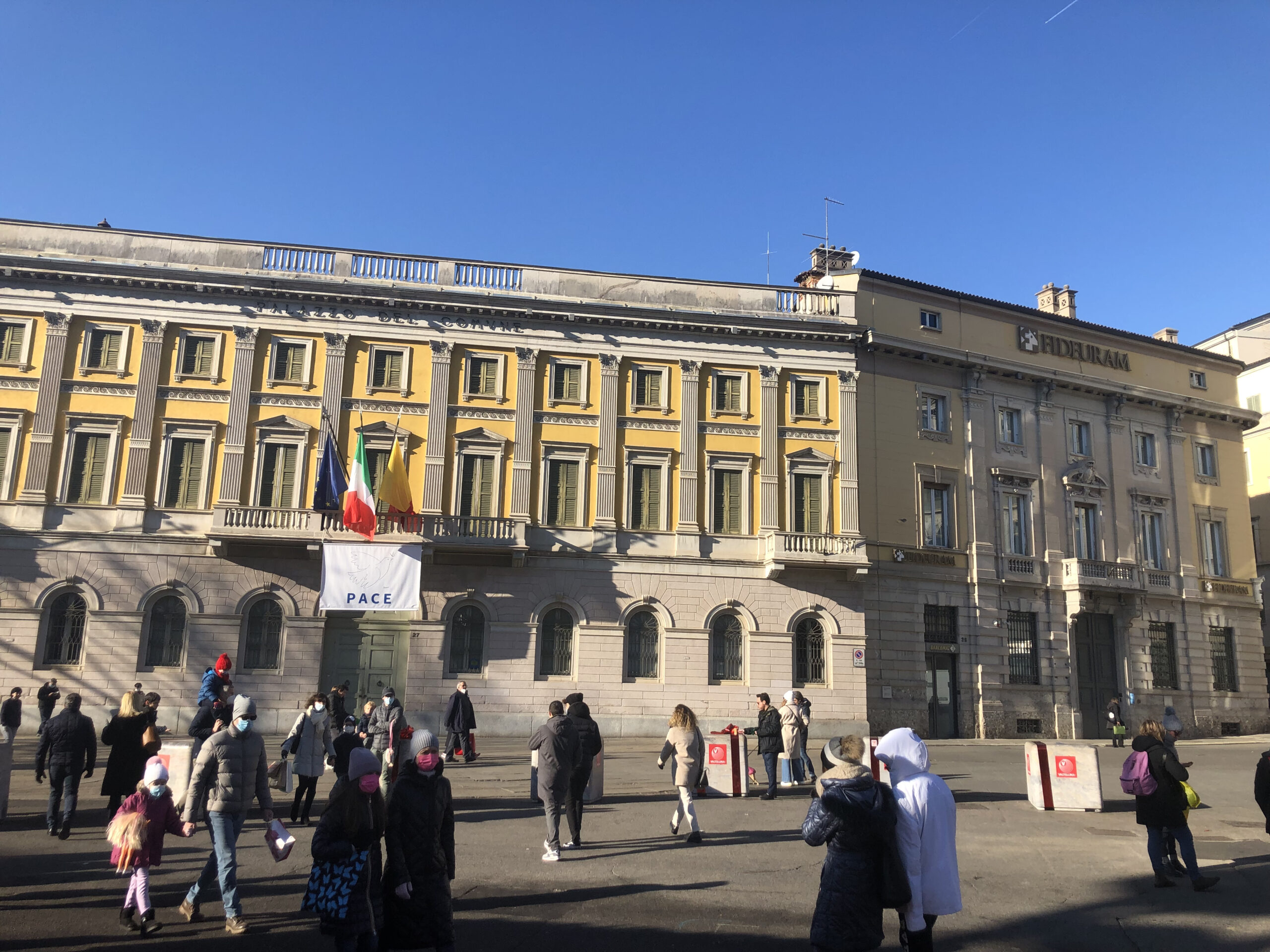
Capital of Culture 2023
Before Covid, Bergamo wasn’t really known or famous. When asked about his city, the mayor had to explain it ‘as a cute city 40 kilometers from Milan, where Ryanair lands’. But other than that, no one knew Bergamo and its characteristics. Suddenly, the city was world news as the epicenter of Covid in Bergamo. ‘The awareness of the city is very wide now, but it is linked to a negative event: Covid. And now we have to turn this awareness into a positive way. We want that Bergamo could be recognized as a city with the capacity to react in an incredible way. It is not easy to overcome the stigma and symbol of tragedy, but the city needs it.’ That’s why Gori applied together with the mayor from Brescia to the Capital of Culture 2023. Every year Italian cities can apply to the Italian chamber of deputies and senate to become the Capital of Culture. In that year all sorts of arts and cultural projects are seen in the cities. In 2023, Bergamo and Brescia is the Capital of Culture, this is the first time that 2 cities applied together. It is rewarded to them as symbol of recovery after a hard time. It is special that the 2 cities came together, Bergamo and Brescia are known as rivals for the last decades. They compete at different levels, they are both created in the medieval, in the same area, lake Iseo is between the cities, they are both old and beautiful and the sports team are on the same level. But they set aside their history for a goal, getting rid of the stigma of Covid. ‘The title and the time are perfect to collect the energies of the communities and to give them direction and strategy. That is what the mayor from Brescia and I are trying to do. Every part of the community should be involved in this project. The schools, industry, workers, the city and of course artists and the culture organizations. It is a good key to push the city out of the bad period characterized by Covid and to give them a future.’ City wide the logo with the capital letter B formed like a 3 is seen, projected on the city hall, posters on windows and as an artwork.
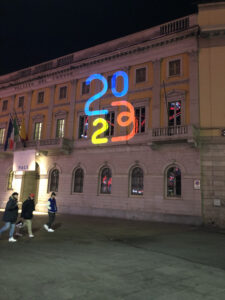
Alessandra Pitocchi works for Visit Bergamo, the official tourist organization. In times of Covid, they prepared campaigns for better times and thought about ways to make Bergamo attractive for tourists again. They are also connected to Capital of Culture. ‘We are busy creating attractions for the Capital of Culture 2023. We are thinking of a way that it is also suitable for after that time, so that is interesting enough to use it even longer. The goal is to create something that remains. Bergamo and Brescia both have Unesco sites, and we want to combine those two.’ Bergamo is divided in two parts, the upper part, Città Alta, is enclosed by an old, 6 kilometers long wall that dates back to the 16th century when Bergamo was part of the Venetian Republic. The Venetian Walls of Bergamo recently became an Unesco site. The Unesco site of Brescia includes important historical and monumental sites. ‘We are planning a camino, a path that connects Bergamo with Brescia. Through the hills, the mountainside, the lakeside and through the beautiful landscape that the area has to offer. We can connect the sites with each other, but people can also visit them individually.’ But there will be a lot of other things to do throughout the year. The two cities have until the end of January 2022 to present a unified project to Italy’s culture ministry, outlining a series of initiatives aimed at strengthening their cultural heritage.
Mola Mia
With everything Bergamo has been through, Giorgio Gori is proud of his city. ‘I saw my city react in a very strong way. I saw it resist when nothing else could be done in the worst months in 2020. And then step by step react and recover. We also learned a lot about ourselves and the community that we are solidary and cohesion among the citizens. At one point I had more than 1,000 young people that were willing to help our most fragile citizens to bring them groceries, face masks and medicines. It was a demonstration of real strength and shared value in a dangerous situation and it showed how strong we were.’ This is the exact thought of Mola Mia, always looking forward and not backwards and working hard for the community.
Enlarge
